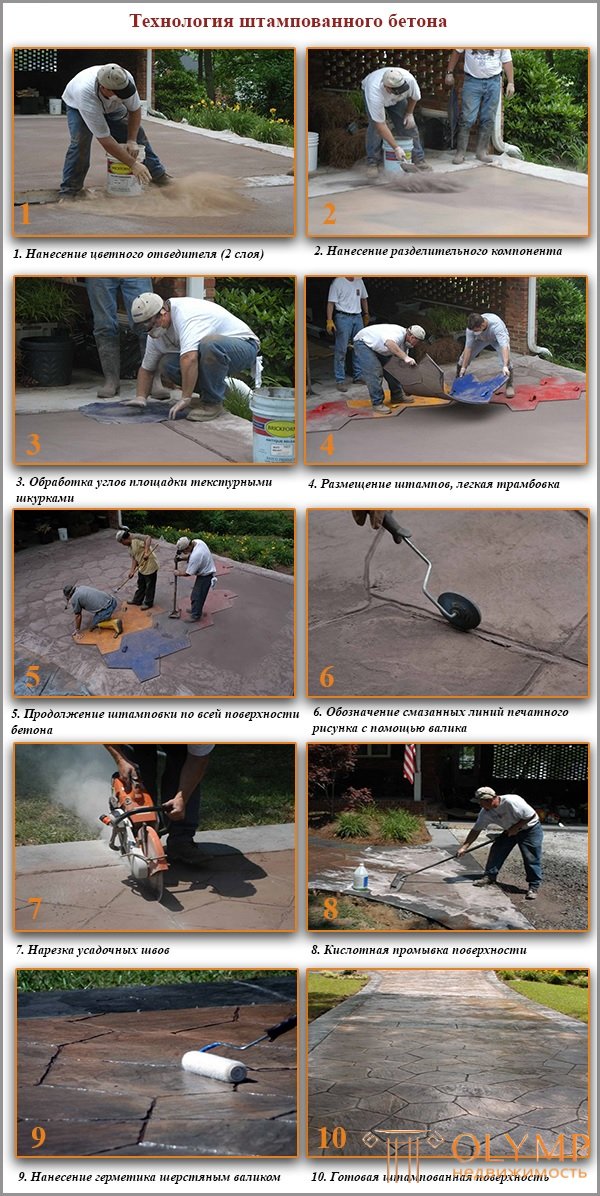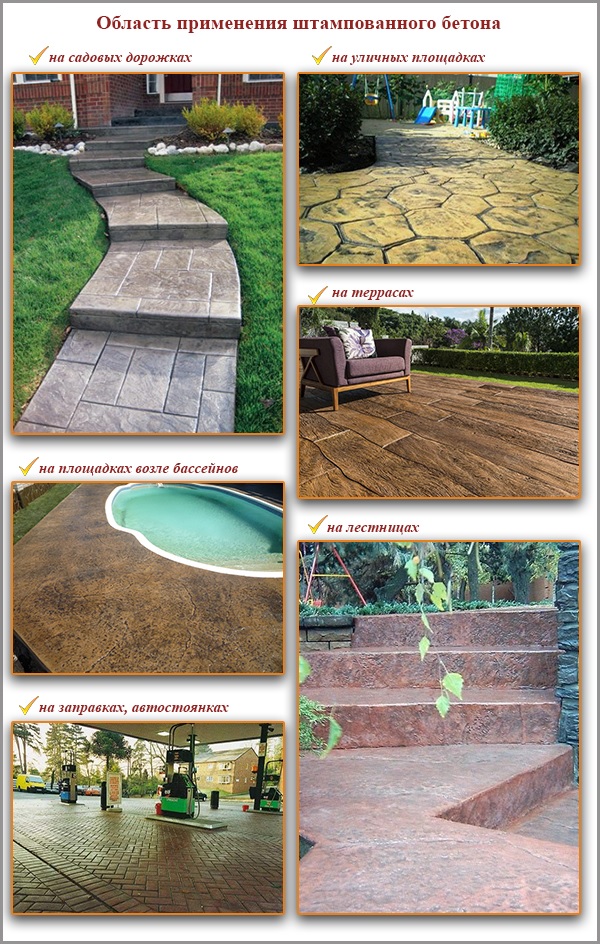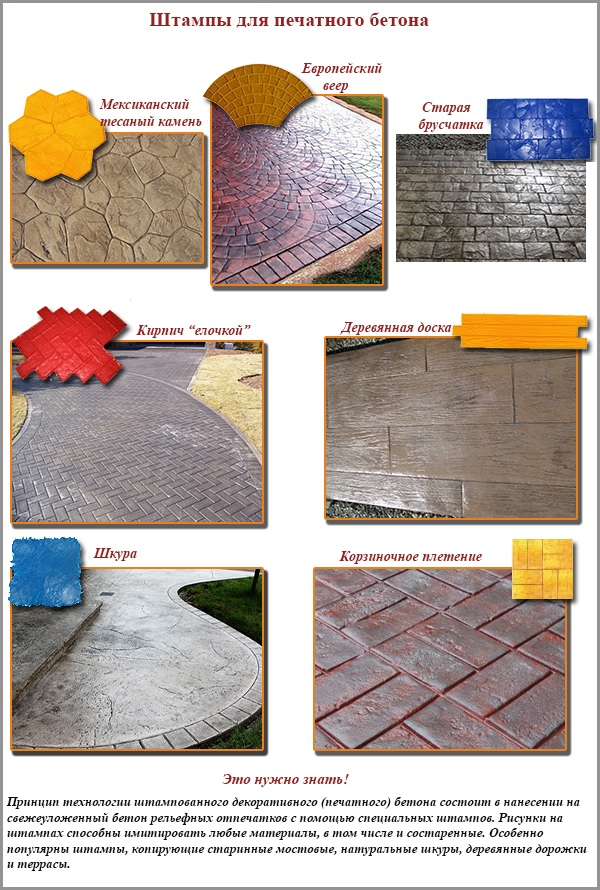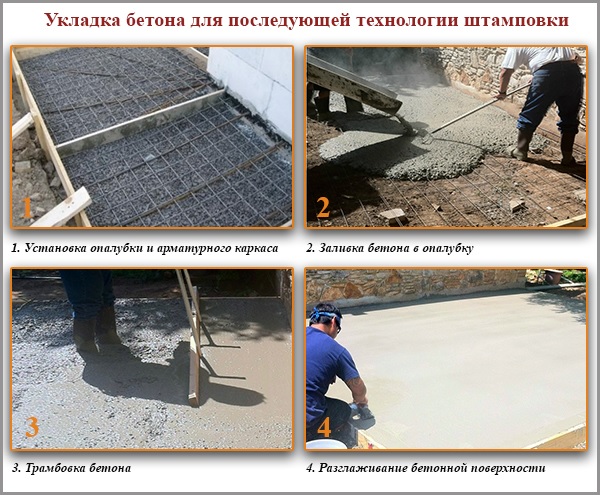
Increasingly, building technologies are emerging that are capable of creating works of art from familiar coatings and materials. Such a transformation is possible even with everyday materials such as concrete. Thanks to the use of polyurethane or metal matrices, a boring concrete surface can become like stone tiles, wooden floors or slate slabs. Such concrete is called stamped, printed or pressed concrete. We will talk about this, as well as about the possibility of creating a printed surface on our own.

Printed Concrete Technology
Stamped concrete - This is ordinary concrete, on the surface of which decorative stamping is applied with special stamps. The relief pattern can imitate any material: brick, paving stones, boards, animal skins, weathered stone, cracked earth. You can pick up stamps with leaf patterns, dinosaur tracks, animal figures.
Pressed concrete is especially popular when decorating terraces, patios, areas near pools, garden paths, sidewalks, gazebos, floors in restaurants and exhibition halls. This technology becomes indispensable for complex restoration work. For example, when it is necessary to recreate the destroyed part of ancient asphalt. Finding exactly the same naturally aged materials is often impossible. And with the help of stamped concrete technology, it’s easy to create exact copies of existing old brick or half-erased stone
RELATED TO REMAIN RELATED TO REMAIN RELAX REMARK
Types of stamps for printed concrete
The first stamps for printed concrete were made of cast aluminum and were massive forms with handles. Such matrices are well suited to simulate conventional brick or stone patterns. But copying complex textures is not in their power. Another thing is modern polyurethane stamps. They are cast on real materials, the texture of which needs to be copied. As a result of this, with the help of polyurethane forms, incredibly authentic texture effects can be obtained.
Ready-made stamps can be purchased at many hardware stores or centers. When choosing, it is worth paying attention to the degree of rigidity of the form. The denser the stamp, the easier it is to use to create a clearly visible picture. Too soft and flexible forms are more difficult to work with, you need to put more effort into them in the printing process.
RELATED TO REMARK

Work execution technology
The technology of stamped concrete is quite simple, but its solution requires only a certain amount of existing skills in working with concrete. Otherwise, the result may be completely different from the one you were counting on. Problems can arise for the following reasons:
concrete hardens quickly, after which the use of dies does not give obvious crowding on the surface;
to perform stamping using stamps, it is necessary to use physical force;
errors in crowded concrete surfaces are difficult to correct;
Pressed concrete technology requires an employee to be skilled in handling special tools to form and level the surface.
If you are sure that you will cope with potential problems, you can start creating a specific site and perform stamping work.
Stage 1. Preparation of the concrete site
The basis for stamping is a conventional concrete platform with reinforcement made of concrete, grade M350 and higher.
The technology for creating such a platform:
using the peg and cord, indicate the boundaries of the area on which stamping will be performed;
remove the top layer of soil (depth 15-20 cm), tamp the bottom of the soil;
pour crushed stone with a pillow (10-15 cm thick) in the lower part of the recess, ram it;
on the border of the site installed formwork of panels;
lay the reinforcing mesh in the formwork, lifting it above the ground by at least 3-5 cm (laying stones, bricks under the mesh);
concrete is kneaded manually using a concrete mixer, or ordered in finished form;
concrete is poured into the formwork, a metal rule is used to obtain the required level of the site;
compact concrete with a vibrorail;
the top layer of concrete is smoothed with a smoothing device, achieving smoothness and uniformity of the surface.

Stage 2. Application of color hardener (iron)
Colored hardener is applied to still fresh concrete, which simultaneously paints the surface and increases its strength. Color hardener is a powder that contains coloring pigments, an astringent filler and crushed particles of granite and silica sand. Due to the dispersion of the mixture, its particles penetrate the pores of the concrete and fill them. The concrete surface becomes denser and stronger. At the same time, the particles give the concrete a steady color (about 30 tones to choose from).
The use of color hardener begins after the initial setting of the concrete surface. You can move around when everything is open

Что бы оставить комментарий войдите
Комментарии (0)